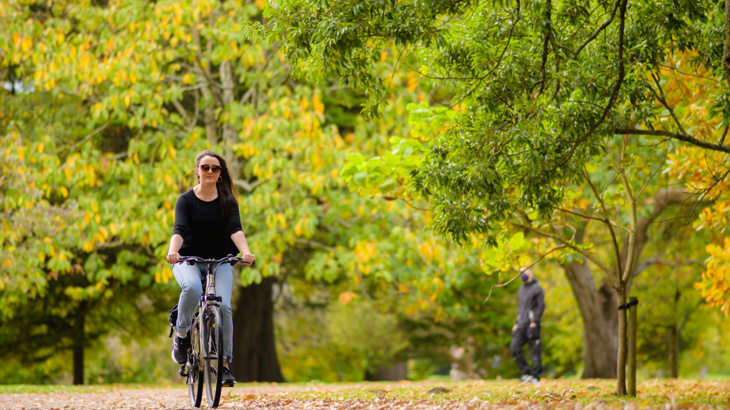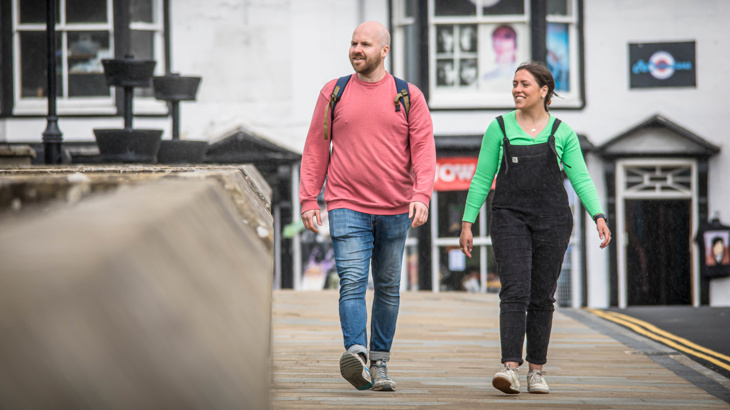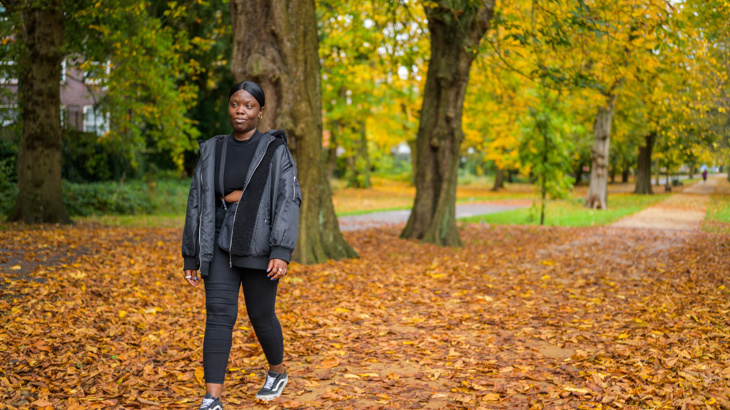In this blog, Sustrans Cymru urban designers, Paria Mundhra and Tiegan Salter, talk about the importance of placemaking and how it can be used as to deal with the effects of climate change.

How we prioritise space in design work can have profound effects on our climate. Credit: ©2020, Jon Bewley/photojb, all rights reserved.
This summer, record-setting temperatures have joined dangerous heat waves across the world in places ranging from America to Germany to China.
It’s also a warning of challenging times ahead, especially for those who live in and work in our towns and cities.
Due to climate change, prolonged periods of hot temperatures are becoming increasingly common, and we’re learning how much our urban areas are struggling to cope.
The effects of climate change on our towns and cities
Our towns and cities are designed for cooler climates, but as the world continues to burn more coal, oil, and gas to power our homes, vehicles, and industry, the likelihood of more frequent heat waves only escalates.
Metropolitan areas are particularly at-risk during heatwaves as increasing temperatures are made worse by the urban heat island effect.
Dark, impermeable concrete and tarmac absorb the sun’s power and radiate it out as heat, keeping our towns and cities warm long after the sun has set.
The very fabric of our urban areas makes them prone to overheating with the potential for them to become deadly, particularly for elderly people or those with underlying health conditions.
With this in mind, we must work together to create and protect the existing and future relationships we have with each other and the places we inhabit.
Climate change is giving us the urgent need and desire to reconnect to our surrounding environments and collectively shape them for our mutual shared benefit through placemaking strategies.

Locations across Wales are all going to face increasing challenges as a result of climate change. Credit: 2022, Geraint Thomas/Sustrans.
Placemaking as a strategy and means for change
Urban greening is a placemaking strategy describing an integrated network of planned and unplanned green spaces in an urban area, spanning both public and private realms.
The successful implementation of urban greening strategies such as stormwater infrastructure, green roofs, parks, and greenways provide a multitude of benefits.
As trees and vegetation shade streets, water evaporates from their leaves (similar to how sweating cools our skin), to lower the temperatures of our urban environments and help to mitigate the urban heat island effect.
Shaded surfaces, for example, may be up to 11-25ºC cooler than the peak temperatures of unshaded materials, making the urban commute much more comfortable by foot or bike.
Urban greening strategies are just as essential to our physical and mental health as they are to the health of our surrounding environments.
For example, a holistic system of vegetated parks, greenways and open spaces increases outdoor human thermal comfort, improves air quality, and decreases the risk of heat-related illness.
Residents living near parks and open spaces have been found to have less psychological distress, be more active socially, and have longer life spans.
Crucial roles of green spaces in urban areas
The COVID-19 pandemic has shown that access to green space is a social justice issue as much as an environmental one.
A 2018 report shows that 2.5 million people live further than a 10-minute walk from a park or green space.
Across the UK population, the amount of accessible green space per person is less than half the size of a six-yard box (the goal area) on a football pitch.
A report by The Guardian also showed that park closures due to overcrowding disproportionately impact BAME (Black, Asian, and Minority Ethnic) and poorer communities, as, statistically, these communities have less access to public parks and private gardens and share less space.
If climate change targets are to be achieved and nature is to be made accessible to all, local and national governments must utilize placemaking strategies as a means of delivering high-quality green spaces in our towns and cities.
Varied and diverse high-quality green spaces will not just benefit us, they will go on to help reverse nature’s decline and mitigate the effects of climate change so that humans and wild species thrive, not just survive, in harmony.
Placemaking can lead the challenge to car dominance
Beyond just changing the physical built environment, placemaking strategies can cool cities by enabling people to rethink how they get around them.
As cars release greenhouse gas emissions, they also produce waste heat, making cities even hotter on hot days.
The existence of cars, and our reliance on them, leads to car-dominated streets and parking facilities covered in tarmac that increase surrounding temperatures.
Although electric vehicles may make a dent in the urban heat island effect, they still convert kinetic energy into waste heat as they move about the city.
Their drivers still require immense, sun-soaked plains of tarmac to park and drive on.
Cities that promote less driving – whether by road lane reductions, narrowing roads, redesigning cycle lanes, or increasing vegetated space – can mitigate the urban heat island effect, encourage active travel, and effectively cool themselves down.
Building resilience in our communities through placemaking naturally addresses the root causes of climate change, whilst reinforcing social life as the pillar of society.

Ensuring that our cities and towns become liveable spaces is a key design priority. Credit: ©2021, Jon Bewley, all rights reserved.
Futureproofing our cities through lessons learned
As a form of heat resilience, placemaking is not just the ability to introduce measures that can tackle one heat wave in the short term.
Rather, it is ensuring the health of everyone living within the city and making sure that the city is liveable in the long term.
Placemaking teaches us through modest necessities, such as walkable communities, shared gathering spaces, and opportunities to celebrate the human experience, that life is vibrant, meaningful, and fun.





